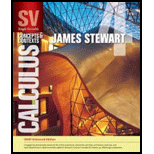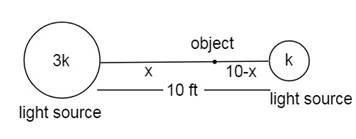
Concept explainers
To calculate: The least illumination of an object by a light source is directly proportional to the strength of the source and inversely proportional to the square of the distance from the source. If two light sources, one three as strong as the other, are placed 10 ft apart, where should an object be placed on the line between the sources.
Answer to Problem 37E
the object should be placed about 5.9 ft from the larger light source
Explanation of Solution
Given information:
The illumination of an object by a light source is directly proportional to the strength of the source and inversely proportional to the square of the distance from the source. If two light sources, one three as strong as the other, are placed 10 ft apart, where should an object be placed on the line between the sources
Formula used:
Let f be a differentiable function defined on an interval I and let a∈I .
Then
- x=a is a point of
local maximum value of f, if - f′(a)=0 and
- f′(x) changes sign from positive to negative as x increases through a , i.e. if f′(x)>0 at every point sufficiently close to and to the left of a , and f′(x)<0 at every point sufficiently close to and to the right of a , then a is a point of local maxima
- x=a is a point of local maximum value of f, if
- f′(a)=0 and
- f′(x) changessign from negative to positive as x increases through a , i.e. if f′(x)<0 at every point sufficiently close to and to the left of a , and at f′(x)>0 every point sufficiently close to and to the right of a , then a is a point of local minima.
- f′(a)=0 and If f′(x) does not change sign as x increases through a , then a is neither a point of local maxima nor a point of local minima.
- If f″(a)>0 then f has a local minimum at x=a
- If f″(a)<0 then f has a local maximum at x=a
Calculation:
As per the given problem
Draw the diagram of the illumination of an object by a light source is directly proportional to the strength of the source and inversely proportional to the square of the distance from the source. If two light sources, one three as strong as the other, are placed 10 ft apart, where should an object be placed on the line between the sources

Let the object is placed x ft from the bigger source then the object 10−x ft from the smaller source
Let the strength of the source be k
Hence, the strength of the bigger source is 3k
Since illumination is directly proportional to the square of the strength and inversely proportional to the distance from the source,
The illumination from the bigger source is =3kx2
The illumination from the smaller source is =k(10−x)2
Hence, the total illumination is
I′(x)=−6kx3+2k(10−x)3
Recall that,
Let f be a differentiable function defined on an interval I and let a∈I .
Then
- x=a is a point of local maximum value of f, if
- f′(a)=0 and
- f′(x) changes sign from positive to negative as x increases through a , i.e. if f′(x)>0 at every point sufficiently close to and to the left of a , and f′(x)<0 at every point sufficiently close to and to the right of a , then a is a point of local maxima
- x=a is a point of local maximum value of f, if f′(a)=0 and
- f′(x) changes sign from negative to positive as x increases through a , i.e. if f′(x)<0 at every point sufficiently close to and to the left of a , and at every point sufficiently close to and to the right of a , then a is a point of local minima.
- f′(a)=0 and If f′(x) does not change sign as x increases through a , then a is neither a point of local maxima nor a point of local minima.
- If f″(a)>0 then f has a local minimum at x=a
- If f″(a)<0 then f has a local maximum at x=a
Differentiate on both sides,
I′(x)=−6kx3+2k(10−x)3 ......(1)
Solve for I′(x)=0 , and simplified
−6kx3+2k(10−x)3=0⇒ 2k(10−x)3=6kx3⇒ 1(10−x)3=3x3⇒ 3(10−x)3=x3
Take cube root on both sides,
3√3(10−x)=x⇒3√3×10−3√3x=x⇒x+3√3x=3√3×10⇒x(1+3√3)=3√3×10⇒ x=3√3×10(1+3√3) ≈5.9 ft
Differentiate equation (1) with respect to x
I″(x)=18kx4+2k(10−x)4
Therefore,
I″(x)=18kx4+2k(10−x)4≥0 provided k>0
For x=5.9 ft is minimum for I
Conclusion:
Thus the object should be placed about 5.9 ft from the larger light source.
Chapter 4 Solutions
Single Variable Calculus: Concepts and Contexts, Enhanced Edition
- please do Q3arrow_forwardUse the properties of logarithms, given that In(2) = 0.6931 and In(3) = 1.0986, to approximate the logarithm. Use a calculator to confirm your approximations. (Round your answers to four decimal places.) (a) In(0.75) (b) In(24) (c) In(18) 1 (d) In ≈ 2 72arrow_forwardFind the indefinite integral. (Remember the constant of integration.) √tan(8x) tan(8x) sec²(8x) dxarrow_forward
- Find the indefinite integral by making a change of variables. (Remember the constant of integration.) √(x+4) 4)√6-x dxarrow_forwarda -> f(x) = f(x) = [x] show that whether f is continuous function or not(by using theorem) Muslim_mathsarrow_forwardUse Green's Theorem to evaluate F. dr, where F = (√+4y, 2x + √√) and C consists of the arc of the curve y = 4x - x² from (0,0) to (4,0) and the line segment from (4,0) to (0,0).arrow_forward
- Evaluate F. dr where F(x, y, z) = (2yz cos(xyz), 2xzcos(xyz), 2xy cos(xyz)) and C is the line π 1 1 segment starting at the point (8, ' and ending at the point (3, 2 3'6arrow_forwardCan you help me find the result of an integral + a 炉[メをメ +炉なarrow_forward2 a Can you help me find the result of an integral a 아 x² dxarrow_forward
 Calculus: Early TranscendentalsCalculusISBN:9781285741550Author:James StewartPublisher:Cengage Learning
Calculus: Early TranscendentalsCalculusISBN:9781285741550Author:James StewartPublisher:Cengage Learning Thomas' Calculus (14th Edition)CalculusISBN:9780134438986Author:Joel R. Hass, Christopher E. Heil, Maurice D. WeirPublisher:PEARSON
Thomas' Calculus (14th Edition)CalculusISBN:9780134438986Author:Joel R. Hass, Christopher E. Heil, Maurice D. WeirPublisher:PEARSON Calculus: Early Transcendentals (3rd Edition)CalculusISBN:9780134763644Author:William L. Briggs, Lyle Cochran, Bernard Gillett, Eric SchulzPublisher:PEARSON
Calculus: Early Transcendentals (3rd Edition)CalculusISBN:9780134763644Author:William L. Briggs, Lyle Cochran, Bernard Gillett, Eric SchulzPublisher:PEARSON Calculus: Early TranscendentalsCalculusISBN:9781319050740Author:Jon Rogawski, Colin Adams, Robert FranzosaPublisher:W. H. Freeman
Calculus: Early TranscendentalsCalculusISBN:9781319050740Author:Jon Rogawski, Colin Adams, Robert FranzosaPublisher:W. H. Freeman
 Calculus: Early Transcendental FunctionsCalculusISBN:9781337552516Author:Ron Larson, Bruce H. EdwardsPublisher:Cengage Learning
Calculus: Early Transcendental FunctionsCalculusISBN:9781337552516Author:Ron Larson, Bruce H. EdwardsPublisher:Cengage Learning





